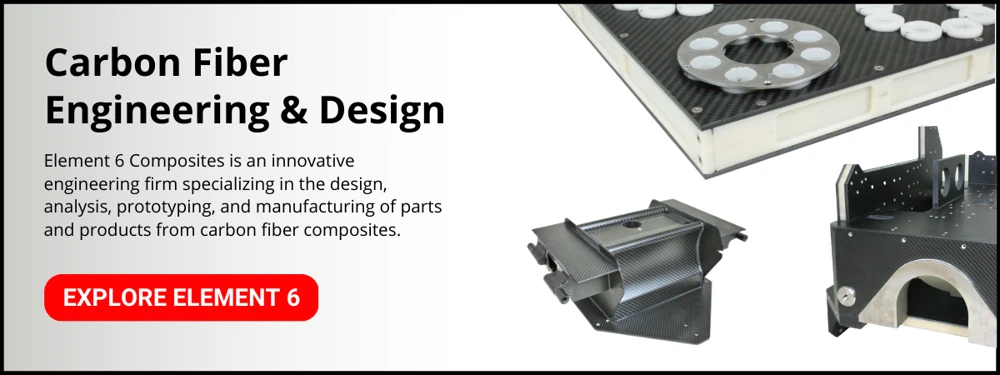A Brief History of Carbon Fiber
Although carbon fiber has been around for more than 150 years, it has only been through manufacturing process improvements in the last half century or so that its excellent strength-to-weight and stiffness-to-weight ratios have been achieved. These modern advances, coupled with decreases in manufacturing costs over the last couple of decades, are what have made carbon fiber become such a popular material for design engineers to use in some of today's greatest technological advances.
Early Carbon Fiber History
Sir Joseph Wilson Swan first created carbon fiber in 1860 to use in an early incandescent light bulb. In 1879, Thomas Edison used cellulose-based carbon fiber filaments in some of the first light bulbs to be heated by electricity. Their high heat tolerance made them ideal electrical conductors. These filaments were made of cotton or bamboo, as opposed to today's petroleum-based raw materials, and then baked at high temperatures to cause carbonization to take place. This baking method, called "pyrolysis", is still used today. Pyrolysis is the process of thermally decomposing organic matter by heating it at high temperatures in an inert atmosphere. When tungsten became the light bulb filament of choice in the early 1900s, carbon fiber was rendered obsolete for the next 50 years or so.
In 1958, at the Union Carbide Parma Technical Center in Cleveland, OH, Roger Bacon accidentally produced the first petroleum-based carbon fibers when he tried to measure the triple point of carbon by heating strands of rayon in argon. He noticed filaments growing on the negative electrode of the arc furnace, and he noted this observation in his findings. However, the resulting fibers were only about 20% carbon and did not have nearly the stiffness and strength properties that are so highly valued in today's carbon fiber products, making Bacon's process highly inefficient. Additionally, his methods for creating the carbon fibers were extremely cost-prohibitive.
Modern Carbon Fiber
 In the early 1960s, Dr. Akio Shindo, of the Agency of Industrial Science and Technology in Japan, used polyacrylonitrile (PAN) as his precursor. PAN is a synthetic, semicrystalline organic polymer resin that allowed Shindo to create carbon fibers that were ~55% carbon using a much more cost-effective production method.
In the early 1960s, Dr. Akio Shindo, of the Agency of Industrial Science and Technology in Japan, used polyacrylonitrile (PAN) as his precursor. PAN is a synthetic, semicrystalline organic polymer resin that allowed Shindo to create carbon fibers that were ~55% carbon using a much more cost-effective production method.
In 1963, British scientists W. Watt, L. N. Phillips, and W. Johnson of the UK Ministry of Defence, patented a new carbon fiber manufacturing process. This manufacturing process created a much stronger carbon fiber product than previous processes yielded. The British National Research Development Corporation then licensed the process to Rolls Royce, Morganite, and Courtaulds. At the time, Rolls Royce was already manufacturing carbon fiber, and this new process allowed them to begin using carbon fiber in the design of their jet engine fan assemblies. They then broke into the US market with their RB-211 aero-engine with carbon fiber compressor blades. Unfortunately, bird impact proved to be a major vulnerability of the compressor blades, which led to major setbacks for Rolls Royce. Ultimately, Rolls Royce sold off their carbon fiber plant.
A joint technology agreement made in 1970 allowed Union Carbide to produce the PAN-based carbon fiber previously only manufactured by Toray Industries in Japan. Morganite had earlier decided that carbon fiber was not part of its core business, which left Courtaulds as the only U.K. manufacturer of carbon fiber. However, their inorganic process left impurities in the carbon fiber that were not seen in the organic process used by other carbon fiber manufacturers. By 1991, Courtaulds, a UK-based manufacturer of fabric, clothing, man-made fibers, and chemicals, stopped production of carbon fiber.
Carbon Fiber Today
Since the late 1970s, several other types of carbon fiber yarn have entered the global market. These newer fibers contain up to 95% carbon and have considerably increased tensile strength and modulus of elasticity over the earliest versions. For example, Toray Industries now manufacturers carbon fibers with a tensile strength of 4,000 MPa and a modulus of 400 GPa. Additionally, improved manufacturing processes have aided in a decrease in production costs. These improvements in strength, elasticity, and cost led engineers in the 1990s and 2000s to finally fully understand the vast potential of carbon fiber in a variety of manufacturing applications, making it a favorite design choice today.
